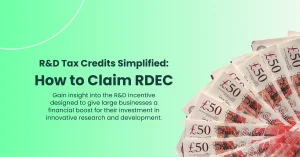How a Stakeholder Management Plan Simplifies R&D Tax Relief

Compiling an R&D tax relief claim can be challenging for businesses, but can an effective stakeholder management plan ease the process? Join us as we navigate the benefits of leaning on stakeholder management plans to simplify R&D tax credit claims, and discover our top tips to improve your R&D process with an actionable plan.
From documenting eligible activities to ensuring HMRC compliance, compiling an R&D tax relief claim can be complicated, and without a clear strategy, it’s easy to make mistakes or miss deadlines.
This is where a stakeholder management plan could simplify the claims process. By aligning documentation efforts and managing deadlines, this form of planning ensures that teams work in tandem to maximise the outcome of R&D relief.
This is how it works…
What is a Stakeholder Management Plan?
A stakeholder is someone who has an interest in a business’s activities. This could range from employees involved in daily operations, to external parties such as customers or organisations with a vested interest in the success of the business.
A stakeholder management plan on the other hand, is a strategy designed to manage and address the interests of stakeholders that may be involved in a specific project.
This ensures that the interests of the stakeholders are understood, leading to a seamless collaboration that aligns various goals and objectives throughout the length of the project.
Book a quick call back
Key Components in a Stakeholder Management Plan
When producing a stakeholder management plan, there are four key components that may result in its successful implementation:
- Identify stakeholders
Recognise those with a vested interest - Stakeholder engagement
Establish communication with stakeholders - Duty assignment
Assign roles to stakeholders involved in the project - Response system
Ensure stakeholder duties are completed and implemented
Importance of Including R&D Tax Relief in a Stakeholder Management Plan
In the context of R&D tax credit relief, the term stakeholders may include teams such as:
- Finance
- Project management
- Research and development team
- Consultants
As a form of innovation funding provided by the British government, R&D tax credit claims require coordination between stakeholders, to compile accurate documentation and meet submission deadlines. Having a stakeholder management plan in place may improve R&D compliance, reducing the possibility of receiving an enquiry.
How a Stakeholder Management Plan Simplifies R&D Relief
An R&D tax credit claim has the ability to reinforce innovation throughout business plans, but the process of compiling a claim can be time consuming without adequate organisation.
With a strategy that organises all parties participating in research and development, stakeholder management plans are able to simplify the claims process by achieving these goals:
- Unifying stakeholders
Stakeholder alignment becomes possible with a stakeholder management plan, which directs everyone’s attention to a common goal - Improving communication
As one of the core components in a stakeholder management plan is the response system, the plan acts as a resource that improves communication and minimises miscommunication - Certifies roles and responsibilities
By delegating tasks, the stakeholder management plan will reduce duplicated duties or gaps in responsibility, while holding individuals and teams accountable for specific tasks - Reduces risks
Proactive development of a stakeholder management plan ensures that required and additional documentation is accounted for, reducing the risk of facing an enquiry - Helps maximise R&D tax relief benefits
With various stakeholders focusing on single aspects of the claim, there’s an opportunity to ensure that qualifying activities and expenditures aren’t missed, which improves the claim benefit
To ensure compliance, HMRC advises businesses to consult with R&D tax credit specialists. As external teams with a vested interest in the success of the R&D claim, these specialists can be incorporated into the stakeholder management plan, with duties such as:
- Verifying qualifying activities and costs align with the latest HMRC policy
- Effectively compiling documentation
- Composing technical narratives that solidify your claim
- Liaising with HMRC on your behalf to ensure deadlines are met
5 Tips to Improve R&D Claims With a Stakeholder Management Plan
Now that we’ve established how a stakeholder management plan can simplify the process of claiming R&D tax credit relief, we want to share how you can build an effective stakeholder management plan that – when put into practice – unifies your team throughout the course of a research and development project.
So without further ado, these are the top 5 tips to preparing a successful R&D claim with a stakeholder management plan.
- Identify stakeholders ahead of time
During the process of project mapping, it’s important to take into account the people involved in the R&D tax credit process. This includes internal teams such as finance and R&D teams, as well as external teams such as R&D advisors.
Early stakeholder identification can help assess the involvement of each individual.
- Set clear objectives
Goal setting will help to determine the R&D objectives that guide stakeholder engagement, while helping them to prioritise specific tasks. Goals can include maximising eligible costs or compliance focus.
- Build a communication strategy
A solid communication plan can enhance team collaboration, while ensuring that stakeholders are aware of their deadlines for R&D claim submissions. Using project management tools and software can be detrimental to this process.
- Assign roles and responsibilities
Effective task allocation can provide stakeholders with role clarity throughout the compilation of an R&D tax credit claim. An example of assigning roles and responsibilities can look like this:
- Finance team track expenses and compile financial records
- R&D team keep up to date documentation on project activities
- R&D tax advisors compile and submit final claim
This form of task assignment can improve collaboration and build an accountability framework.
- Monitor and adapt processes
By regularly reviewing the stakeholder management plan, it is possible to implement adaptive management techniques that ensure each team remains aligned throughout the project – even as it evolves with different challenges and changes to tax policy.
This provides an environment of continuous improvement.
Alexander Clifford’s Role in an R&D Focused Stakeholder Management Plan
As one of the UK’s leading R&D tax credit advisories, the team at Alexander Clifford is an effective stakeholder in your R&D tax credit claim process.
Providing specialist knowledge of the latest R&D policy, our team lends their meticulous attention to detail to maximising claims while maintaining the highest standard of compliance. So far, this has allowed our team to submit over 2,400 successful claims on behalf of our clients, securing over £83 million in R&D tax credit relief.
That’s what makes Alexander Clifford your trusted choice for R&D tax credits.
If you’re ready to maximise your R&D tax credit claim with a team that’s dedicated to compliance, fill in the contact form below, or book an appointment with one of our specialist advisors.
Get a decision on your R&D eligibility from a qualified specialist in 15 minutes.







